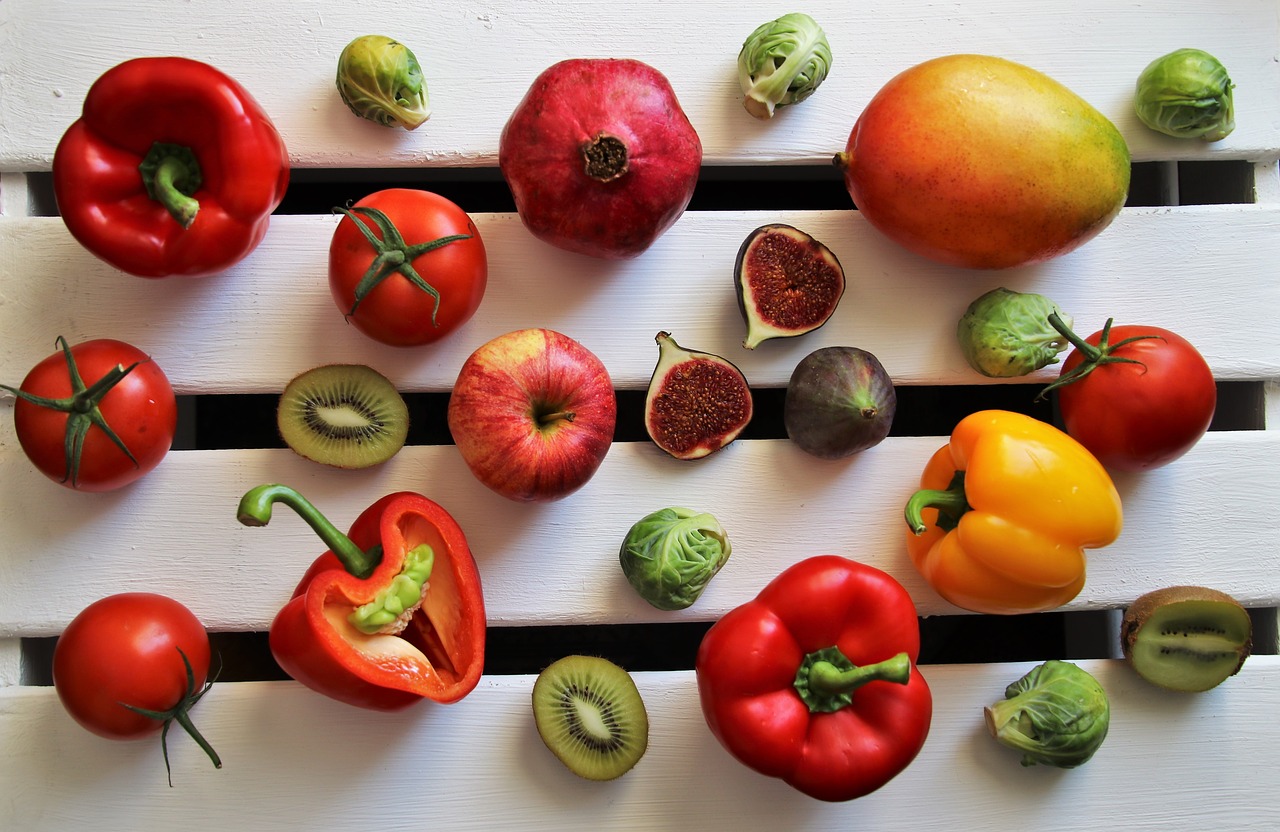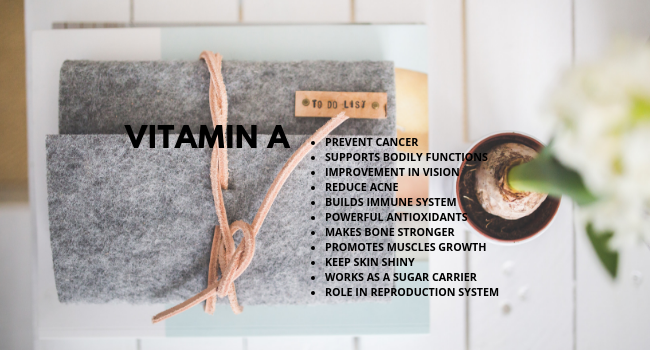Vitamin A is a one of fat-soluble vitamin that represents the different form of the organic compound “retinoid”. As you know there are 13 types of vitamins. These vitamins are categorized mainly into fat soluble and water soluble vitamins . All 13 vitamins are equally important for your body to function properly. They have different role in your body. We have dedicated this article exclusively about Vitamin A, as why do we need Vitamin A. [spacer height=”5px”]
Vitamin A plays a very important role in the immune system and human metabolism. Vitamin A is needed for the growth and maintenance of skin and the inner lining of the body. Vitamin A is essential for the proper function of Eye and Vision. It aids in the resistance to infection. Vitamin A needed for bone Development and proper sperm formation. Vitamin A also helps with some cancer cases. So far you might have an idea why do we need vitamin A in a balanced amount.
In this article, we are going to talk about this particular type of fat soluble vitamin and explore certain points related to it.
Page Contents
What is Vitamin A?
|
Group |
Vitamers | Provitamins |
| Vitamin A | Retinol
Retinal Retinoic Acid |
Beta-Carotene Cryptoxanthin |
Vitamin A is an umbrella term which refers to the various forms of retinoid (an organic compound which is found in various plants and animals).
It is a fat-soluble vitamin, which means it is dissolved in fat and can be stored for a long time (primarily in the liver).
Two Forms of Vitamin A are available in the human diet :
- Preformed Vitamin A
- Provitamin A
1-Preformed retinoids: Vitamin A exists as preformed retinoids, which are stored in animal tissue. It includes Retinol, Retinal, and Retinoic acid. ( found in Meat, fish, Poultry and dairy foods.)
Retinol, Retinal, and Retinoic acid are the active form of vitamin A.
Most of the preformed vitamin A in the diet is in the form of retinyl esters (C21H30O2). Retinyl ester(Storage Form ) are hydrolyzed in the lumen of the small intestine to yield retinol.
Vitamin A is also known as a Retinol.
2-Provitamin A carotenoids: The carotenoids are present in both plant and animal food products. Carotenoids pigments are widespread among diverse animal species, with more than 500 different compounds estimated. About 60 of those have provitamin activity.
Beta-Carotene is one of 60 carotenoids of known 500. Beta-Carotene is a precursor, So it is called “Provitamin A” it means your body uses these carotenoids to make Vitamin A in your body.
Other nutritional carotenoids including lycopene( Watermelon is a great source of lycopene), lutein, and zeaxanthin can function as antioxidants.
CHEMISTRY :
Retinol: – C20H30O – found in animal tissues as ‘Retinyl esters’ with long chain fatty acids
Retinal : – C20H28O – oxidation of retinol – Retinol & Retinal are inter-convertible
Retinoic acid: – C20H28O2 – oxidation of retinal – Retinoic acid cannot form retinal or retinol
β – Carotene: C40H56 -There are two ways in which beta-carotene could be converted to vitamin A: either by cleavage at the Center or by breaking the molecule down from one end
The second of these is thought to be most important biologically. The breakdown of beta-carotene occurs in the walls of the small intestine and is catalyzed by the enzyme beta-carotene dioxygenase.
Read also, about
Why do we need Vitamin A? (Know health benefits of Vitamin A)
We have already discussed the roles that vitamin A plays in the proper functioning of the human body in brief. We’re now going to dig a little deeper.
- Vitamin A plays a vital role in the visionary system of human beings especially night/low light vision (which is very much dependent on vitamin A). Retinol creates the pigment in the retina of the eye which is very sensitive to light; due to this, a person can see decently in a low light condition. This also helps improve the overall health of the eye and ultimately the vision. Moreover, vitamin A helps protect the surface of the eye (which is called “cornea”). A regular intake of vitamin A can help slow down the symptoms and complications of a condition called “retinitis pigmentosa”. [spacer height=”5px”]
- Vitamin a Play an essential role in systemic function, they include roles in the differentiation and growth of epithelial cells and in growth in general. [spacer height=”5px”]
- Vitamin A acts as a sugar carrier in the synthesis of the glycoprotein. [spacer height=”5px”]
- Vitamin A is essential for growth, fetal development, and tissue maintenance. It is required at various stage of embryonic development. [spacer height=”5px”]
- Vitamin A is necessary for reproduction system. [spacer height=”5px”]
- Vitamin A has an essential role in the normal metabolism of bone. Retinoids are involved in regulating the phenotypic expression of bone-mobilizing cells. [spacer height=”5px”]
- Vitamin A appears to have a role in the normal health of the skin. (13-cis-retinoic acid can be used for the treatment of Acne, It dramatically reduces sebum production, However, 13-cis-retinoic acid can also be teratogenic, so use it under strict medical supervisions.) [spacer height=”5px”]
- The epidemiological investigation has repeatedly found an inverse relationship between the level of consumption of provitamin A containing food and the risk of chronic disease including cardiovascular disease, stroke, and cancer. [spacer height=”5px”]
- Many research suggested that Provitamin A carotenoids have a role in Chronic disease prevention.
Vitamin A deficiency (Know all possible sign and symptoms of Vitamin A)
Vitamin A deficiency is not common in the developed countries but there’s a high risk for a citizen based on a developing country to suffer from it.
This deficiency can cause either simply because of inadequate intake of Vitamin A or other underlying difficulties like a liver condition.
A person whose iron and zinc intake is low is also susceptible to vitamin a deficiency. This is because iron helps our body to absorb and process the Vitamin A and zinc allows it to reach necessary parts of our body for it to work.
As already discussed people with liver problems are also likely to face this deficiency because vitamin a is primarily stored in our liver. That’s why people with behaviors like regular drinking which leads to the degradation of the liver, is at the risk of suffering from the deficiency.
Pregnant women based in developing countries are also very likely to suffer from vitamin deficiency, causation is – a high amount of vitamin A is required during pregnancy for the proper formation of the fetus. It’s also true for lactating women as well as infants who need a relatively higher dosage of vitamin A.
- A person suffering from vitamin A deficiency will most likely to have a condition called “night blindness” since retinoid plays an important role in the visionary system.
- Other symptoms are slow bone development, improper immune function, slow cell growth, and infections etc.
| Organ System | Sign |
| General | Loss of appetite
Retarded growth Drying and keratinization of membranes Infection |
| Dermatologic | Rough Scaly skin
Rough hair/feathers |
| Muscular | Weakness |
| Skeletal | Periosteal over growth
Restriction of cranial cavity and spinal cord Narrowed foramina |
| Vital Organs | Nephritis |
| Nervous System | Increased cerebrospinal fluid pressure
Ataxia Constricted optic nerve at foramina |
| Reproductive | Aspermatogenesis
Vaginal cornification Fetal death and resorption |
| Ocular | Nyctalopia
Xerophthalmia Keratomalacia Constriction of optic nerve |
Best Sources of Vitamin A ( Know Vitamin A sources)
We’ve already discussed, vitamin A naturally occurs in both animals and plants.
As liver is the primary storage point of vitamin A, it’s also a rich source of it. For plants, it’s recommended to look for varied colors fruits and vegetables, like dark green, yellow and orange.
We’ve sorted down all possible sources of Vitamin A below:
| Food | IU/100 g | RE(g)/100 g |
| Animals Products |
10,503 41 130 28 552 253 754 |
35,346 140 434 94 1839 856 3058 |
| Beef Lever
Poultry Meat Mackerel Herring Eggs Swiss cheese Butter |
||
| Plant products |
– 15 171 7 4 2 – – – – – – – 993 |
– 149 171 67 39 24 420 21,600 11,000 1,330 16,00 – – 3,307 |
| Corn
Peas Beans Chickpeas Lentils Soybeans Green Peppers Red Peppers Carrots Peach Pumpkin Yellow Squash Orange sweet potatoes Margarine |
Measurement
1 retinol equivalent (RE) =1 g all-trans-retinol
= 2 g all-trans β-carotene in dietary supplements
= 12 g all-trans- β-carotene in foods
= 24 g other provitamin A carotenoids
For pharmaceutical applications :
1USP unit (or IU) =0.3 g all-trans-retinol
= 0.344 g all-trans-retinyl acetate
= 0.55 g all-trans-retinyl palmit

